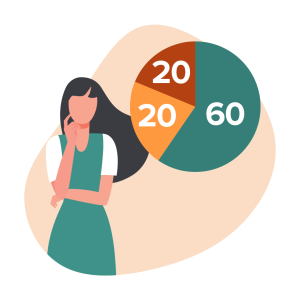How Much Of My Income Should I Be Saving?

Francis Taylor
Last Updated: 19th October 2022
There’s no one-size-fits-all approach to saving. Since everybody’s financial situation is a little bit different, each person will need a unique savings strategy to match.
For instance, someone on a limited income might have to spend most of their money on groceries and rent, while someone who earns a lot may have a lot more opportunities to save. What might be suitable for you all comes down to your personal circumstances.
How much income can you spare?
To begin, it may be a good idea to look at how much money you can reasonably set aside each week (or month). This is not too different from making a budget; it involves looking at how much you earn, how much you need to spend on living expenses and the amount that you have left over.
What’s left after essentials?
These are the necessities of everyday life, expenses like groceries, rent, petrol, utility bills, mortgage repayments and car repayments.
You may want to look at how much these things typically cost you. Gather up your recent receipts and bills and work out how much you usually spend on a weekly or monthly basis. Then subtract this from your regular income.
Let’s use Kathy as an example here. She’s a receptionist who takes home $850 (after tax) each week. On average, she pays $550 in essential expenses: $350 in rent, $100 in groceries, $50 on utility bills and $50 on car expenses, such as petrol and insurance premiums.
In this case, she has $300 left over each week. That’s $300 she could potentially save.
What’s left after non-essentials?
Of course, people don’t just buy essentials. Everybody deserves to treat themselves now and again and this is where expenses such as recreation, fancy new clothes, electronics or regular subscriptions fees to Spotify or Netflix come into play.
One way you can get a good feel for your financial situation is by estimating what you spend on non-essentials. Then, subtract this from your remaining income.
Let’s go back to Kathy to see how this works. On average, she spends $90 a week on nights out with her friends, $50 a week on new clothes, $54 on gadgets and $6 on Netflix. All up that’s $200.
Since she has $300 left after buying the essentials, the $200 on non-essentials will leave her with $100 to save (or spend) each week.
Is it enough?
Ultimately, it’s up to you to decide how much you want to save.
If you’re saving up much more than you anticipated, then you could keep your spending habits as they are or buy that fancy new laptop you’ve had your eye on. Alternatively, maybe you’ve noticed some non-essential expenses that you can scale back. By doing so you could free up more money to save or invest.
What do you need for an emergency?
Depositing a fraction of your savings into an emergency fund might also be worth considering.
As noted by the ASIC website Moneysmart, an emergency fund can provide a useful safety net in case something sudden and unexpected ever happens to you or your family1.
This could be a medical crisis, unexpected travel costs or emergency repairs if your car ever breaks down in the middle of nowhere.
Moneysmart points out that even setting aside a little bit each week can provide some peace of mind. A weekly deposit of $30 adds up to $1560 a year – and that might be enough to try and help make the worst that life can throw at you a little more bearable.
Which savings strategy is best for you?
Let’s face it, it’s not up to us to tell you how much you should save. So let’s go for a better approach. By going over some of the different savings strategies that people use, you might be able to find one that suits your needs. Ready? Let’s begin.
The 50-30-20 rule
We’ve mentioned this handy guideline in some of our other articles. Popularised by US Senator Elizabeth Warren in her book, All Your Worth: The Ultimate Lifetime Money Plan, the 50-30-20 provides a simple way to divvy up your after-tax income2:
- The first 50% goes to your essentials
- 30% goes to your non-essentials
- 20% goes towards a savings account or investments
This can be a great way to save up a significant amount of your income – provided your essentials only take up 50% of your earnings. The main drawback? For many Australians it could be impractical. With the cost of living on the rise, some families might really struggle to cover all the essentials with just 50% of their household income.

The 60-20-20 rule
Similar to Warren’s rule, but perhaps a little more useful for those with thin budgets, is the 60-20-20 rule. Created by the best-selling Australian author Scott Pape (aka the Barefoot Investor), it advises a slightly different approach3:
60% of your after-tax income goes to essentials
20% should go towards non-essentials and treating yourself
20% should be split between a savings account and paying off debts
When it comes to your savings, Scott advises building up $2,000 in a high-interest savings account. After this, he suggests using the money you save to get rid of any debts, paying off the smallest first before moving on to the bigger ones.
Pay yourself first
The premise of this strategy is simple. You begin with a savings goal in mind; maybe it’s $50 a week, maybe it’s $1000 a month. Then you set up an automatic deposit so that the amount always goes into your savings account4.
You can do this by setting up a periodic transfer on your transaction account. Or, as noted by Moneysmart, you can ask your employer to transfer a part of your pay directly into the savings account5. Whichever way is easiest.
An advantage of this strategy is that it is incredibly flexible. It allows you to save $10 a week if you’re just scraping by and it allows you to save more if you’re in a better situation.
It also “locks in” a savings amount before you put your money towards living expenses and recreation, so it’s always sensible to work out how much you’ll need to survive before setting up these automatic transfers.
What can I do to boost my savings?
Swearing off that 7 am coffee from an up-scale barista might help you build up your savings in the long run. Then again, it might be worth going through the whole gamut of your expenses to see what else you can reduce.
iSelect might be able to help with this too. We offer a range of comparison services for gas and electricity, insurance, credit cards, home loans and more. With us, you can find a competitive price by comparing a range of different providers and plans. So get started online today if you’re interested!
1 Save for an emergency fund – Moneysmart.gov.au
2 https://www.investopedia.com/ask/answers/022916/what-502030-budget-rule.asp
3 How to Make a Budget — The Barefoot Investor – Scott Pape
Francis Taylor
Content Writer

Articles that might interest you
Budgeting & Saving
VIEW ALL
How to Save For a House Deposit In 2022
BY Francis Taylor | 19th September 2022
How on earth are you supposed to save up for a home? This is a question on the lips of many Australians – especially ...

How Much Of My Income Should I Be Saving?
BY Francis Taylor | 19th September 2022
There’s no one-size-fits-all approach to saving. Since ev...

What Is Inflation & Why Does It Matter?
BY Francis Taylor | 19th September 2022
Let’s face it – when it comes to the economy, things coul...

How to Create a Family Budget
BY Francis Taylor | 19th September 2022
Are you and your partner looking to start a family? Or pe...